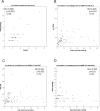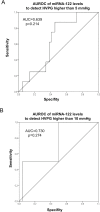Circulating miRNA-122 levels are associated with hepatic necroinflammation and portal hypertension in HIV/HCV coinfection
- PMID: 25646812
- PMCID: PMC4315411
- DOI: 10.1371/journal.pone.0116768
Circulating miRNA-122 levels are associated with hepatic necroinflammation and portal hypertension in HIV/HCV coinfection
Abstract
Background: Introduction of combined antiretroviral therapy (cART) has improved survival of HIV infected individuals, while the relative contribution of liver-related mortality increased. Especially in HIV/HCV-coinfected patients hepatic fibrosis and portal hypertension represent the main causes of liver-related morbidity and mortality. Circulating miRNA-122 levels are elevated in HIV patients and have been shown to correlate with severity of liver injury. However, the association of miRNA-122 levels and hepatic fibrosis and portal hypertension remains to be explored in HIV/HCV coinfection.
Methods: From a total of 74 (31% female) patients with HIV/HCV coinfection were included. Serum levels of miRNA-122 were analyzed by quantitative polymerase chain reaction (PCR) and normalized to SV-40 spike-in RNA. Hepatic venous pressure gradient (HVPG) was measured in 52 (70%) patients and the fibrosis stage was determined in 63 (85%) patients using transient elastography.
Results: The levels of circulating miRNA-122 were increased in HIV/HCV coinfected patients and significantly correlated with the alanine aminotransferase (ALT) (rs = 0.438; p<0.001) and aspartate transaminase AST values (rs = 0.336; p = 0.003), but not with fibrosis stage (p = n.s.). Interestingly, miRNA-122 levels showed an inverse correlation with hepatic venous pressure gradient (HVPG) (rs = -0.302; p = 0.03).
Conclusion: Elevated miRNA-122 levels are associated with liver injury, and with low HVPG. Though, miRNA-122 levels are not suitable to predict the degree of fibrosis, they might function as indicators for portal hypertension in HIV/HCV coinfected patients.
Conflict of interest statement
Figures



References
-
- UNAIDS (2013) in Global Report 2013.
Publication types
MeSH terms
Substances
LinkOut - more resources
Full Text Sources
Other Literature Sources
Medical
Miscellaneous

